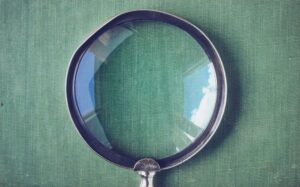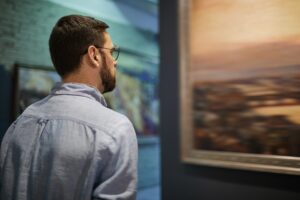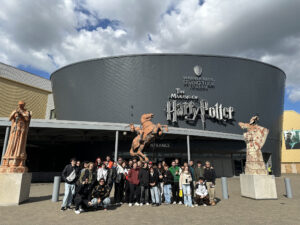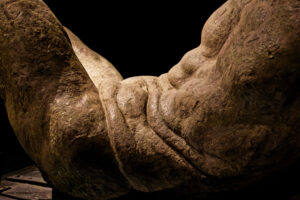by Inna Khegay
Despite the protests, Sébastien Lecornu’s ‘moves’ and the recent closure of the Louvre following a daring theft, on 22 October Paris inaugurated the Art Basel Paris fair on the Champs-Élysées, bringing together 206 galleries from 41 countries under the magnificent glass dome of the Grand Palais, built for the Universal Exhibition of 1900 and recently restored with an investment of €466 million.
The Alma Mater of the Avant-Garde in search of balance
Paris – symbol-city, source of inspiration, ‘alma mater’ of the historical avant-garde – for over 100 years was considered the main artistic centre and fashionable workshop of the old and new worlds. Post-Impressionism, Fauvism, Cubism, Surrealism… Pablo Picasso, Amedeo Modigliani, Van Gogh, Matisse, Marc Chagall… Their creativity gave a powerful impulse to all contemporary art.
However, due to the aftermath of the Second World War, in the mid-20th century New York, and towards the end of the 20th century London, ousted Paris from the podium as the art capital of the world.
After the UK’s exit from the EU, bureaucratic, logistical and fiscal complications weakened London’s position, and Paris became the natural beneficiary of Brexit, becoming once again the creative centre of Europe. Moreover, France’s focused and consistent cultural policy, which has always been very attentive to its heritage (especially the Louvre!) and national identity, has restored the ‘fever’ and interest of international collectors and market players to Paris.
The turbulence of the art market and the shifting centres of power
The art market today reflects the instability of the global economy.
According to the latest Art Basel+UBS report, total global sales volume decreased by 12% to USD 57.5 billion in 2024. Data from the ArtPrice analysis for the last year (including the first half of 2025) show a significant drop of 25% in the volume of auction sales of contemporary authors (born after 1945), signalling the longest period of contraction in the history of the contemporary art market since 2022.
The market has entered a phase that can be described as “trans-vertical”. Instability is changing the balance of power on the map: while the US ($24.8 billion with 43% of global sales) retains primacy, London (18% with $10.4 billion) and China (15% with $8.4 billion) alternate in 2nd and 3rd place (Art Basel+UBS).
Meanwhile, Paris, despite the crisis, is steadily gaining strength, firmly maintaining 4th place since 2016 with 7% of world turnover (4.2 billion). Last year, Paris became the most dynamic business location – in terms of number of transactions, France ranked 2nd, second only to the USA.
Art Basel Paris 2025 – an authentically Parisian atmosphere
Art Basel Paris, as a regional project of the transnational giant Art Basel, is unique – the city determines its character. Although it does not have as large an area as Basel, Hong Kong or Miami (only 13,500 sqm), the fair attracts visitors from all over the world thanks to its significant cultural context – you go to Paris for Paris! Art Basel Paris (until 2024 Paris+ par Art Basel) for the past four years shows us how the ‘French’ approach to doing business overlaps with global ambitions.
“We are committed to creating an authentic identity,” says fair director Clément Delepine: “The exceptional quality of this year’s projects is tangential proof of the magnetism of Art Basel Paris and the central role that Paris and France continue to play in the global art market and in culture in general. Thus, the French art scene, where traditionally more than half of the exhibitions are devoted to local authors, balances national identity and international openness.
The ambitious public programme: museums, foundations, patrons
Art Basel Paris impresses with the scope and richness of its parallel programme, organised in partnership with the city’s leading institutions.
In 2025, Paris Art Week turned Paris into a huge exhibition square, a crossroads for all imaginable art forms. Monumental installations can be seen at Place Vendôme, Palais d’Iéna, Cité de l’Architecture, Chapelle des Petits-Augustins, courtyard of the Institut de France, avenue Winston-Churchill… Cognitive dissonance among art critics was provoked by the giant inflatable ‘frog’ themed object by the American-Venezuelan ‘master of the supernatural’ Alex Da Corte at Place Vendôme.
At iconic venues – the Louvre, Musée d’Orsay, Musée de l’Orangerie, Musée d’Art Moderne, Palais de Tokyo, Musée Picasso, Jeu de Paume, Lafayette Anticipations – exhibitions, fashion shows, curatorial tours and lectures are taking place, included in the Paris Art Week programme.
The Petit Palais presents Julius von Bismarck’s work ‘The Elephant in the Room’, in which a mechanised taxidermy of a giraffe and an equestrian statue of Otto von Bismarck fall and recover in asynchronous cycles.
Also at the Petit-Palais, all visitors have access to the open conversation series ‘Conversations’ with legendary fashion editor Edward Enninful as guest curator.
At the same time, specialised exhibitions take place as part of Art Week: Paris Internationale (avant-garde contemporary art), Design.Miami (design works in the magnificent 18th-century building), AKAA (African art and design) and Asia NOW (Asian and diaspora art).
After Jean Nouvel’s extensive renovation, the Fondation Cartier inaugurates its new premises in Place Palais-Royal with the Exposition Générale project, presenting over 600 works.
Museums, foundations and artists’ residences in the French capital are springing up one after the other thanks to the support of patrons, including two key figures as poles of attraction: Bernard Arnault and François Pinault. In the ‘battle of the billionaires’, competing to create collections and museums, Paris is always the winner.
Bernard Arnault (the richest man in the world in 2024), head of the luxury conglomerate LVMH Moët Hennessy Louis Vuitton, owner of a fine collection of several thousand works of art, founded a museum in 2014 in the Bois de Boulogne, which has become an important part of the cultural landscape – the Fondation Louis Vuitton, where a Gerhard Richter retrospective can currently be seen.
François Pinault, owner of the auction house Christie’s, the holding company Kering S.A. and the football club ‘Rennes’, opened his museum Collection Pinault-Paris in 2021 in the restored building of the Bourse de Commerce, where contemporary art exhibitions are regularly held, including from Pinault’s personal collection of more than 10,000 works. As part of Paris Art Week, the museum mounted the exhibition ‘Minimal’, featuring works by the pioneers of 1960s minimalism from private collections.
The exhibition sections. Masterpieces and major sales
The spatial solution of the exhibition is dictated by the unique architecture of the Grand Palais, with its circular glass dome and the openwork balconies of the mezzanines. The exhibition is divided into three zones – three main sections: Galeries, Emergence and Premise.
Art Basel Paris brought together visionary gallery owners, innovative artists and interdisciplinary projects. This year’s main theme is the avant-garde through dialogue between epochs, from historical legacy to contemporary debates.
Significantly, almost a third of all galleries (65 out of 206) are resident in Paris, including Mennour, Le Minotaure, Galerie Christophe Gaillard, Thaddaeus Ropac, Almine Rech, Perrotin, Mor Charpentier, Concept. Closely linked to the city are the names of many of the artists represented, both French and émigré, who have chosen this place to live and create: Simone Fattal, Bertrand Lavier and Sheila Hicks; Nathanaëlle Herbelin, Ethan Assouline and Xie Lei, American Bob Thompson, Hungarian Simon Hantaï, Odesite Sonia Delaunay and Korean master Park Seo-Bo…
This year the organisers, in addition to First Choice, experimented with a new preview format – the Avant Première, an ultra-exclusive event by special invitation (no more than 6 per gallery), for a more confidential contact with the professional public. Nevertheless, on all preview days the queue of VIPs stretched from the entrance of the Grand Palais on avenue Winston-Churchill almost to the Champs-Élysées.
Among the visitors were representatives of 240 museums and foundations, including Centre Pompidou, Louvre, Tate, M+ Hong Kong, Aspen Art Museum, MCA Chicago, National Gallery of Art, Guggenheim Museum, MoMA PS1, Metropolitan…
The audience of guests was international: American collectors (Beth Rudin DeWoody, Craig Robins, Mugrabi family), European (Delphine Arnault, daughter of Bernard, Carla Bruni, Maja Hoffmann, Tony Salame) and Asian (Purat Osathanugrah, son of Thai collector Petch). French President Emmanuel Macron, Culture Minister Rachida Dati were at the fair. First Lady Brigitte Macron was seen chatting politely at the Grand Palais stands.
Galeries – the core of the fair with 180 leading dealers with works from different periods and currents – from the early 20th century avant-garde to post-war radicalism. This time the galleries focused on ‘eternal values’ and ‘blue chips’ – that which is time-tested and always in demand: Picasso, Basquiat, Richter, Baselitz, Bacon, Warhol… – dozens of works of the highest level! A surprise for many was the museum-level exhibition of 9 works by Pablo Picasso from Nahmad Contemporary (about half of the works have already been sold). The front-runner in contemporary art, Gagosian Gallery, caused a stir by exhibiting a painting by Peter Paul Rubens worth $10 million on its stand.
In the opening hours, the fair was visited by some 6,000 selected guests, and large eight- and seven-figure negotiations took place between the top galleries and their key clients. The total sales volume on the first day of Avant Première alone was around $90 million.
Hauser & Wirth sold Gerhard Richter’s 1987 abstract painting ‘Abstraktes Bild’ for $23 million. The German artist, whose feverish interest was fuelled by the exhibition at the Fondation Louis Vuitton, became the record holder of the fair: an abstract painting by Richter from 1988 was bought from Lévy Gorvy Dayan. Although the gallery did not specify the price, this work had previously gone to auction at Christie’s for $27.2 million. A painting by Gerhard Richter was also sold at David Zwirner’s stand for $3.5 million, and at White Cube for $2.5 million.
Modigliani’s masterpiece ‘Jeune fille aux macarons’ (Young Woman with Gathered Hair, 1918) from Pace Gallery was purchased by a European institution for approximately $10m. This transaction is part of a long collaboration between Pace and the Restellini Institute in preparation for the publication in 2026 of the catalogue raisonné of Amedeo Modigliani. Also from Pace, a work by Romanian artist Adrian Ghenie was purchased for $1.5 million.
Among the works purchased from the Hauser & Wirth stand – Bruce Nauman’s neon composition ‘Masturbating Man’ for $4.75 million, Lucio Fontana’s ‘Spatial Concept, Waiting’ for $3.5 million and a new painting by American artist George Condo ‘Femme de Monaco’ for $1.8 million.
Thaddaeus Ropac sold Alberto Burri’s ‘Sacco e oro’ (1953) for €4.2m and 2 works by Georg Baselitz: ‘Cowboy’ (2024) for €3.5m and ‘Geste Winken’ (1995) for €1.2m.
White Cube sold a 1989/2003 Baselitz sculpture ‘Dresdner Frauen – Elke’ for €2.5m and a 2001 Luc Tuymans painting ‘Bend Over’ for $1.35m.
In addition to Takashi Murakami for $550,000, the Perrotin Gallery sold more than 10 works by Maurizio Cattelan (author of the well-known banana installation) for between $174,000 and $209,000.
At the David Zwirner gallery, a painting by Martin Kippenberger was bought for $5m. Yares Art also reported good results, having received an offer of $4m for a large work (width 260 cm) by Frank Stella.
Karma Gallery sold Matthew Wong’s 2017 painting ‘White Wave, Black Sand’ for $3.5m.
The prices of women artists’ works confirm the recognised global importance of women’s art. For the painting ‘Charioteer’ (2007) by the Ethiopian-American artist Julie Mehretu, the White Cube gallery obtained about $11.5 million, David Zwirner sold a wire sculpture by the Japanese-American Ruth Asawa for $7.5 million, an expressive painting by Joan Mitchell for $3 million and Marlene Dumas – for $2.5 million. For a work by the American ‘Colour Field abstract’ artist Helen Frankenthaler, Yares Art grossed $4 million. From Xavier Hufkens a ‘Young British Artists’ star Tracey Emin was bought for $1.61m and a master of portraiture Alice Neel (known in Russia for her Moscow exhibitions in the 1980s) for $1m. At Gladstone Gallery – ‘Kiss (Love)’ by the well-known for stylised images of celebrities Elizabeth Peyton – for $1.3 million. At Pace Gallery, Agnes Martin’s minimalist painting ‘Children’s Playing’ was purchased for $4.5 million, as well as a work by Australian Aboriginal artist Emily Kame Kngwarreye ‘Alatji – wild yam’ for $550,000.
The use of basic cultural codes and recourse to universal themes in times of crisis – in the Lego brick panel ‘The Last Supper’ by the Chinese ‘ambassador of conscience’ Ai Weiwei.
Landau Fine Art, representing Post-Impressionism and Fauvism, exhibited Kees van Dongen’s ‘The Clown’ worth 13.5 million.
Emergence (Emergence, Birth): a section for young galleries, most of them participating in the fair for the first time, located on the mezzanines above the main hall. This symbolic place – a vantage point for looking into the future. Presented here are 16 solo projects by emerging artists, but who have already demonstrated their potential, whose works reinterpret materiality and identity through bold installations, collages and sculptures.
The London gallery Ginny on Frederick dedicated its stand to a single monumental sculpture by the French-Iranian artist Arash Nassiri.
Hong Kong’s Blindspot brought erotic works by Xiyadie, cut out on paper using the traditional Chinese technique.
Emergence participants reported less collector activity than on the first floor – many simply could not get up to the 2nd floor during preview days. Most deals were concluded online, but some galleries had purchases from the stand: Jessica Silverman sold two bronze works by Davina Semo for $25,000 each and Atsushi Kara’s painting ‘Nature’s Resilience’ for $12,500. The interest of art institutions was aroused by the mobile sculptures of clothes and textiles in THE PILL by Greek-Parisian Nefeli Papadimouli.
Premise (Foreword, Prologue): in a separate aisle of the building, essential curatorial projects were set up, which overturn ideas about the objects of creativity and the chronology of art. In this section of the fair, one can see works created before 1900, interspersed with ultra-modern art. Each of the 9 conceptual exhibitions tells its own story, affirms a certain way of thinking, and transforms our perception.
Tina Kim Gallery brought abstract works of traditional fabric by Korean artist Lee Shinja from the years 1950-2000 to France for the first time, selling 4 works: for $150,000, $70,000, and two for $90,000. Another work was booked by an American institution.
The Gallery of Everything exhibited works from the 1940s by the first black surrealist, hereditary voodoo priest from Haiti – Hector Hyppolite.
Attracting attention was a joint presentation by New York dealer Gordon Robichaux and Stars of Los Angeles, which exhibited the toy dioramas of Janet Olivia Henry.
The Pavec Gallery presented the first solo exhibition at the International Art Fair of Marie Bracquemond – the rediscovered grand dame of Impressionism, 7 works from the years 1870-80 were sold at prices ranging from $45,000 to $60,000.
The Bauhaus pioneers were not neglected either: Kadel Willborn showed gelatin photos by Lucia Moholy, and Galerie Eric Mouchet – graphics by Ella Bergmann-Michel.
Oh La La! “à la mode”
Paris still dictates ‘haute couture’: an enduring trend has become the symbiosis of the fashion world and art – Louis Vuitton/Jeff Koons, Dior/Peter Doig/Saroyama, Loewe/Miyazaki, Alexander McQueen/Damien Hirst collaborations…
The fantastic Artycapucines VII – Louis Vuitton x Takashi Murakami collection is presented on the balcony of honour of the Grand Palais. The artist arranged 11 bags created for Louis Vuitton between the tentacles of an 8-metre octopus. Flowers, pandas, mushrooms and dragons completed this ‘psychedelic garden’ of fashion retail. The success of the collaboration with Murakami prompted Louis Vuitton to invite other artists: Sol LeWitt, James Rosenquist, Richard Prince, César, Yayoi Kusama.
The use of ‘eternal art’ as a resource of inspiration in a time of crisis gives new meaning to the ephemeral images of the catwalks. The ‘Oh La La!’ initiative, taking place for the second year, invites galleries on 24-25 October to change their exhibitions according to a given theme, intriguing visitors. This year the project takes place under the motto ‘à la mode’ and is curated by the well-known journalist and fashion editor Loïc Prigent.
The revaluation of heritage: balancing the national and the global
France focuses on the modernisation of classical heritage and the revaluation of rediscovered names. Paris does not live off the past – it capitalises on it, turning history into a strategic resource.
If in past decades the world’s leading trendsetters were representatives of Anglo-Saxon art – the ‘civilisation of white men’, the geography of influence has expanded in recent years. By insistently declaring post-colonial narratives, Art Basel Paris focuses not only on European and American art, but also on African, Chinese, Indian and Japanese art… The organisers have achieved a balance between international scale and ‘French identity’, making the fair an autonomous cultural brand, distinct from Basel – with a strong national core and openness to the global context.
Conclusion: Is Basel worth Paris?
The well-structured strategy, ‘cultural diplomacy’ and the influx of international collectors indicate that, despite the socio-political crisis, Paris has justified its ambitions as a global centre of the arts.
The participants of Art Basel Paris, moving away from ultra-modern speculative projects and turning to “eternal values”, bet on the “blue chips” – exceptional artists of the past and present, with established careers and serious institutional support: Picasso, Modigliani, Degas, Richter, Condo… And the bet worked – the success of the 4th edition of the fair instils optimism and hope.
The exhibition at the Grand Palae attracted over 73,000 visitors, and Art Week showed an unprecedented dynamic, involvement and emotional charge thanks to the magnetism of the French capital.
Today, Art Basel Paris aspires to be the flagship of the brand. Or perhaps it is Paris that influences Art Basel?



